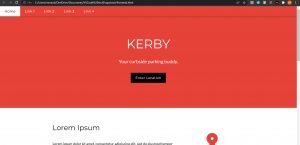This week each one of us was focused on starting the integration process, as per our gantt chart. The ethics discussion on Monday was also helpful because we received constructive feedback from other teams in the A section who did not know much about our project from the beginning of the semester. One of the teams mentioned how our sensors could be misused, not only by a temporary object (like a pigeon) but by humans that would like to claim their spots/show them as blocked on our app (similar to the “Pittsburgh chair”). Our integrations involve 1) persisting wifi connections on site to upload from the sensors to dynamoDB 2). Running continuous db query jobs in containers to serve our web app request. We have checked that our ESP8266 power/wi-fi connections and AWS lightsail respectively can allow us to run continuous programs performing these tasks. If everything goes according to plan, we should be able to do the final integration of all three subsystems before the interim demo.
Month: March 2022
Kanvi’s Status Report for 3/26
This week I continued to work with the hardware. I kept struggling with a “safe boot” process to use MicroPython on the ESP8266 and have made it possible to load code but don’t have it communicating perfectly yet. Instead, I decided to just focus on using some Arduino code to make a simple interface with the MQTT broker. In time I have set aside tomorrow, I will get data on to the database, ready for lab time on Monday! I also tested out some batteries (using a AA battery container plugged into the board) but I think I may need to do some calculations and plug in some resistors to make a self-sustaining board. Then I plan to make 3! I’m excited to have everything be pulled together and ready for the demo.
Neville 3/26
This week I worked on refining the original database query code to work for our app. It now takes the Mqtt data as input( as opposed to mock data )and uses an automated batch writer to store multiple sequentially arriving payloads to the DB. I also worked on spinning up container resources using AWS light sail to run our backend programs. I’ve written a containerizer script that obtains the needed files and runs our database dump entry point program. I will soon replicate that for the mqtt portion. This will I will work with Minu to complete coding up our backend detection algorithm
Mrinmayee’s Status Report 3/26
This week I continued to work on developing our web app. I edited some of the frontend designs that were given in the template I was using last week. Additionally, I worked on figuring out how to connect the backend of the webapp to the database where we are storing sensor information. I have coded up all the helper functions that are independent of the query process such as converting from address to latitude longitude coordinates, finding the distance between two coordinates, finding the top k closest parking spots, etc. My main goal was to find a way to query the DB by the end of the week. However, I still need to work with Neville tomorrow or in the upcoming week to finish the integration and start testing this part of the project. As for tasks for next week, I will be helping the rest of the team with field testing to make sure that the predicted 8ft distance between sensors works or if it needs to be tweaked slightly.
Team 03/18
As a team, we are focusing on prepping for everything we will need done for our interim demo. The ethics assignment was an interesting thought exercise for us, as it helps us consider what exact data we should be collecting and potential misuses of our product. This guided Minu’sdevelopment of the web application, in both implementation translations and backend implementations. We want to ensure that the UI is as simple and clear as possible, by translating our parking sensor data into the most digestible graphical format. We have a goal by the end of the next week to get data from our hardware module to our database and then to display something on our GUI. We are following our gantt chart so far and require no changes. Our biggest risk still remains the same issue of our algorithm using multiple sensors being able to detect the presence of cars accurately. We will perform field testing next week and come up with experimental results
Mrinmayee’s Status Report 3/19
This week I spent most of my lab time working on starting a framework for our web application. Since I have no prior experience in web development, I found this week’s work quite interesting and challenging. I chose to use Flask as our framework. Additionally, I used an online template for the frontend as a starting point. I have explored creating endpoints, using form actions, and rerouting urls. I spent the most time implementing GET and POST requests, since we would need it when the user tries to input their location somehow on our app. Additionally, I have started to code up some of the backend functionalities. Next week, I hope to work with Neville and figure out how to query the database from the app. We hope to start integration next week. Here’s a quick view of what the web app will look like.

Neville 03/18
Over the past two weeks I have worked on setting up our ioT communication pathway: specifically the mqtt message transfer & database dump. I have been able to set up necessary security permissions on our AWS account and configure DynamoDB and AWS ioT core to receive mock input records and messages respectively. An AWS console image is posted below & the code for this can be found in the dev branch of our github https://github.com/18500-Kerby/Kerby/tree/dev (It’s private because we thought it should be that way but if you’d like access to monitor our progress just say so). The next step iterating on this would be to i) Run experiments varying parameters e.g batch write throughput, TCP keep alive settings to analyze their effect on latency ii) Setup containers on Amazon LightSail to persist a job running the code for our communication pathway.

Kanvi’s Status Report 3/19
I was able to get into the lab and work on flashing code onto our ESP8266 board! I ordered some micro USB cables and picked them up on Thursday to make sure we were no longer stopped because of the lack of these in the lab. Initially, I worked on having Arduino code running. I have the ultrasonic sensor returning distance measurements pretty accurately, using some simple sample code. I started the next step of adding wifi capabilities, which was connecting our module to the school wifi. Because I would not be able to register it on CMU-Secure, I connected it to CMU-Device. To do this, I ran an Arduino script that outputted the MAC address of the device in the serial monitor and registered this on the CMU-Device website. With this much working, I was content with moving forward with MicroPython. On VSCode, I downloaded the PyMakr extension and was able to have it recognize the ESP8266 connection to my computer! I have been experiencing some errors with “safe booting” the board when trying to flash MicroPython code onto it, but I think I have found some posts on the internet to help me fix this problem! Hoping to have our ultrasonic sensor uploading data to our database before we get back into the lab on Monday. Once I set up a couple more sets of sensor and board, I believe our hardware will definitely be ready to go for the interim demo!
